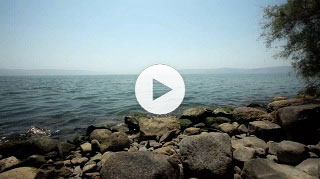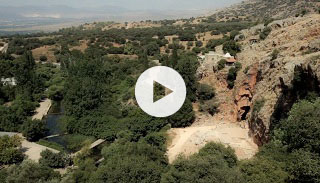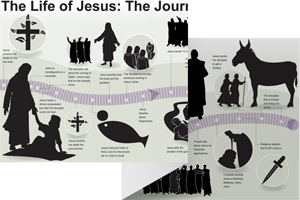16:1–4 The Pharisees |
16:1 Pharisees See note on John 1:24.
Sadducees See note on Mark 12:18.
a sign from heaven A means of authentication. Prophets who claimed to speak on God’s behalf often had to prove their assertions (see Exod 4:1–9; 7:8–13). “Heaven” is likely a figurative reference to God, although the Jewish leaders may have wanted to see a celestial sign (e.g., Matt 24:27, 30).
Prophets who claimed to speak on God’s behalf often had to prove their assertions (see Exod 4:1–9; 7:8–13). “Heaven” is likely a figurative reference to God, although the Jewish leaders may have wanted to see a celestial sign (e.g., Matt 24:27, 30).
16:3 not able to evaluate the signs Jesus’ point is that the Jews could predict the weather based on simple observations, but they could not discern the presence of the kingdom of heaven through His miracles (“the signs of the times”; compare 4:17).
16:4 sign of Jonah See note on 12:39.
16:5–12 Jesus warns His disciples about the misguided teachings of the Jewish leaders. He speaks metaphorically, and, as usual, the disciples misunderstand. Jesus then warns them plainly and reminds them that He can meet their needs. |
16:5 at the other side Refers to the Sea of Galilee. Jesus and His disciples apparently got into a boat when they left in v. 4.
Jesus and His disciples apparently got into a boat when they left in v. 4.
16:6 leaven Yeast or leaven typically symbolizes sin or impurity in the Bible, though Jesus used it earlier as a positive metaphor (13:33).
16:8 you of little faith Jesus uses this phrase when responding to his disciples, who struggled to believe that God would take care of them (6:30; 8:26; 14:31; 16:8).
16:12 teaching of the Pharisees and Sadducees Likely a reference to their oral traditions (see 15:2 and note), as well as their opposition to Jesus.
(see 15:2 and note), as well as their opposition to Jesus.
16:13–20 Peter reaffirms Jesus’ identity as Messiah (compare 14:33 and note). In response, Jesus promises to establish His church in an enduring way through Peter. |
 Jesus’ Declaration at Caesarea Philippi
Jesus’ Declaration at Caesarea Philippi
16:13 Caesarea Philippi City about 25 miles north of the Sea of Galilee, at the base of Mount Hermon and near the source of the Jordan River.
Who do people say that the Son of Man is Here, Jesus asks the question in a general sense. Later, in v. 15, He identifies Himself as the Son of Man.
the Son of Man See 8:20 and note.
16:14 Some say John the Baptist Given the proximity and closely aligned message of Jesus and John the Baptist, this is a natural connection (see ch. 3; compare Mark 1:7–8,14–15).
this is a natural connection (see ch. 3; compare Mark 1:7–8,14–15).
Elijah Jesus’ ministry closely reflects Elijah’s.
Jeremiah A prophet of judgment and repentance who was strongly opposed by the religious leaders of his day.
16:16 You are the Christ The Greek word used here, christos, meaning “Christ,” “Messiah,” or “anointed one,” is equivalent to the Hebrew, mashiach, which primarily describes kings in the ot (see 1:1 and note). This is the second such confession by Jesus’ disciples (compare 14:33).
 Jesus’ Declaration at Caesarea Philippi
Jesus’ Declaration at Caesarea Philippi
the Son of the living God In contrast to the pagan gods associated with their surroundings at Caesarea Philippi (see note on v. 13).
(see note on v. 13).
16:17 Jonah Probably a reference to the name of Peter’s father (compare John 1:42).
16:18 you are Peter There is a wordplay here, as the name Peter is associated with the word for “rock” in both Greek (the language of the nt text) and Aramaic (the language spoken by Jesus and the disciples). Interpretation of Jesus’ meaning hinges on how the wordplay is understood.
on this rock This may refer to Jesus, Peter as a leader (compare v. 16), Peter as a representative of the leadership of the church, or the Church in general.
my church One of three occurrences of the word “church” in the Gospels (compare 18:17).
 The Church Devotional
The Church Devotional
the gates of Hades In this instance, this likely refers to the realm of the dead in general (the underworld)—similar to the Hebrew word she’ol. Jesus and His disciples are at Caesarea Philippi, located at the base of Mount Hermon. This region is affiliated in ancient Near Eastern, Jewish, and Greek literature with the gateway to the underworld, the gods, and other spiritual beings. The ot also affiliates the region, called Bashan in the ot, with an evil giant clan and idolatry (Deut 2:10–12; 3:1,10–11; Josh 12:1–5). Jesus seems to be saying that through His power, the Church will overcome the powers of evil and death itself.
16:19 keys of the kingdom of heaven Refers either to the authoritative roles given to Peter and the apostles or to the Church as the advocate for God’s ways and spreader of the message of salvation.
whatever you bind Binding and releasing may refer to what Peter and the church leaders prohibit (bind) or permit (release). This seems to indicate that the Church and its leadership are given authority to carry out God’s will and to oppose the powers of evil (compare Matt 12:29–32).
16:20 they should tell no one As the next passage indicates, Jesus knows that His messianic role will involve suffering and death, and He apparently recognizes a divine timetable for these events to unfold. Compare 8:4 and note.
16:21–23 For the first time in Matthew’s Gospel, Jesus predicts His death. Peter does not comprehend the notion of a suffering Messiah (compare Isa 52:13–53:12); instead, he focuses on the power and authority described in Matt 16:18–19. Jesus rebukes Peter for failing to grasp the larger purposes of God’s plan. |
16:21 From that time on This marks the end of Jesus’ Galilean ministry, as He turns toward Jerusalem and the events that must take place there.
chief priests Prominent priests who were involved in Jewish religious government.
and be raised on the third day The first time Jesus mentions this to His disciples.
16:22 Peter took him aside A reversal of roles between student and teacher. Peter thinks he knows better than Jesus what He should do, and he sharply criticizes Him. In Peter’s view, the Messiah should not have to endure the suffering that Jesus predicts.
16:23 Get behind me, Satan With a sharp rebuke, Jesus confronts Peter’s misunderstanding of the Messiah’s ultimate mission. Peter’s implicit desires align better with Satan’s aims (to convince Jesus to avoid suffering and death; 4:1–11) than with God’s plan (the cross).
16:24–28 Jesus revisits His earlier remarks about taking up one’s cross (10:38–39). If His opponents kill Him, His disciples can reasonably expect a similar fate. Although they will receive positions of honor, discipleship will be costly. |
16:24 take up his cross See 10:38 and note.
16:25 whoever wants to save his life Compare 10:39.
16:27 the Son of Man is going to come Compare 13:37–43; see 8:20 and note.
according to what he has done Referring to v. 25. Compare Psa 62:12.
16:28 some of those standing here Among the disciples (see Matt 16:5, 13, 21, 24).
the Son of Man coming in his kingdom The meaning here—and in the parallel statements at Mark 9:1 and Luke 9:27—is difficult to determine. A reference to the transfiguration is unlikely, since it occurs only six days later (Matt 17:1).

|
About Faithlife Study BibleFaithlife Study Bible (FSB) is your guide to the ancient world of the Old and New Testaments, with study notes and articles that draw from a wide range of academic research. FSB helps you learn how to think about interpretation methods and issues so that you can gain a deeper understanding of the text. |
| Copyright |
Copyright 2012 Logos Bible Software. |
| Support Info | fsb |
 Loading…
Loading…





